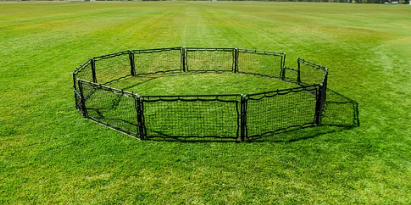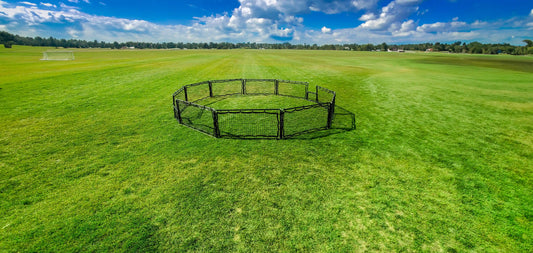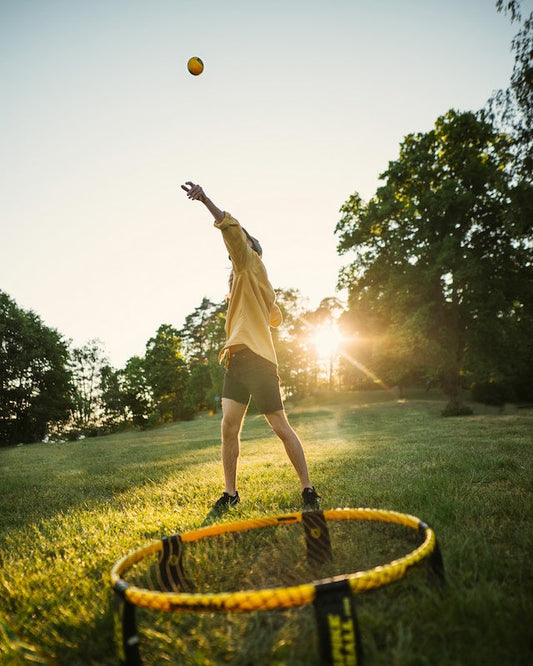As a dedicated PE teacher, you understand the importance of keeping your lessons fresh and engaging. While sports like soccer and basketball certainly have their place in P.E. class, it's essential to introduce students to a variety of team building activities that challenge both their physical and mental skills. One fantastic way to achieve this is by incorporating target games into your curriculum. These games not only help students develop their hand-eye coordination, precision, and strategic thinking, but they also add a layer of excitement and healthy competition to your lessons. In this blog, we'll explore the world of target games, from the classics like archery and darts to the more innovative and quirky activities that can breathe new life into your P.E. classes. Made with the youngest child in mind, all the way up to high school, we've got 6 great ideas for any p.e class. Get ready to hit the bullseye in your teaching approach and offer your students an exciting, skill-building experience allowing them to discover a hidden talent with the best indoor & outdoor target games for physical education!
Bean Bag Tic Tac Toe:

Bean Bag Tic Tac Toe with Hula Hoops is a fun and interactive outdoor game that combines the classic strategy of Tic Tac Toe with the physical challenge of tossing bean bags through hula hoops. This game is the perfect physical activity and friendly competition, this works for any lesson plan, especially with younger students!
Materials Needed: Nine hula hoops, 10 bean bags (five of one color, five of another),Open outdoor/indoor space
Setting Up the Game: Lay Out the Grid: Place the nine hula hoops on the ground in the shape of a Tic Tac Toe board, with three rows and three columns. Make sure they're evenly spaced and aligned to form the playing grid. Assign Participants: Determine who will be X and who will be O. You can use colored bean bags to represent each player's symbol. For example, one player can have five red bean bags (X) and the other four blue bean bags (O). Objective: The goal is to get three of your bean bags in a row, either horizontally, vertically, or diagonally, inside the hula hoop grid. Taking Turns: Each participant will take a turn tossing their bean bags onto the grid from a designated starting line, typically a few feet away from the hula hoop grid. The toss must be underhand, and the players must stand behind the starting line when throwing. Game Strategy: Players should aim to form a winning pattern while blocking their opponent's attempts. Just like in traditional Tic Tac Toe, you need to plan your moves strategically to win. This creates a fun way to involve strategic thinking at the same time as defending your plan from getting interrupted. Scoring: If a beanbag lands inside a hula hoop, it stays in place until the end of the game. If it lands outside, it's out of play for the round. Winning the Game: The first player to get three of their bean bags in a row (horizontally, vertically, or diagonally) inside the hula hoop grid is the winning team. You can adjust the distance between the starting line and the hula hoops to make the game more or less challenging for either an older or young person. If playing in teams, have one team player split between 2 sides, while the opposite team is on the other 2 sides, to allow for an entire team to easily reach all areas of the grid.
9 square
9 Square is a fun game that combines volleyball and four squares, creating an exciting and engaging team building activity. This game is designed to encourage teamwork, team bonding, and friendly competition, making it perfect for youth groups, schools, camps, and churches.
How to Play: Nine players stand in a three-by-three grid, with the middle square being the King or Queen square. Positions spiral outward until the bottom corner, known as square nine, the starter square. If a participant misses the ball, they must move down to the last square, and all other team members move up. The common goal is to reach and stay in the King or Queen square. Since everyone has the same chance to move up, the game promotes team dynamics and leadership skills. If a player hits the ball out of the grid or drops it, they’re out, making way for new players. This game is ideal for team building activities as it keeps youth engaged while fostering team morale and coordination. It’s an excellent team building game for a youth group, whether played as a relay race, problem-solving challenge, or team architect strategy game.
There are many scoring Systems and ways to create a target goal including:
Assigning points for each action. For example: staying in the King/Queen square for a set time = 5 points, getting another player out =2 points. First player to reach a target score which could be whatever number you want, wins the round. Teams can track their scores over multiple rounds to encourage strategy and make the game longer.
Team Play: Instead of individual rotation, split players into teams of 4 or 5 and assign points based on team performance. Teams work together to keep their members in the King/Queen square while trying to knock out the other team’s players. A team wins if their player holds the King/Queen square for a set time (3 minutes).
Skill Based Challenges: Players aim for specific squares instead of just hitting the ball randomly. Limit players passes, This requires a player to pass the ball to at least one other player before they can send it to a new square. One Hand Rule, Players can only use one hand, this is to increase difficulty.
Timed Rounds: For this version you need a countdown timer (3-minute rounds) The players play for the duration of the 3 minutes and last player standing wins.
Why 9 Square is the Perfect Team Building Game: It encourages team spirit and healthy competition, It can be played indoor or outdoor, making it a great team building exercise for all occasions, Ideal for large groups or a smaller team, as long as there are at least 9 participants, A fun way to engage youth, including high schoolers, in a problem-solving skills challenge, Keeps team members moving in and out of the game, ensuring maximum participation.
Bocce Ball:
Bocce ball, often simply referred to as "bocce," is a classic Italian lawn game that has gained popularity worldwide. It is a leisurely, yet highly strategic game that can be enjoyed by people of all ages and skill levels. Bocce ball is typically played in a relaxed outdoor setting, such as a backyard, park, or a dedicated bocce court.
Equipment:
Bocce Balls: These are typically eight heavy, solid balls, four of one color and four of another. The goal is to throw your bocce balls closer to the target ball, (called the “pallino,”) than your opponents. Anything the size of a tennis ball works great.
Pallino: The pallino is a smaller, usually white, ball that serves as the target. It's thrown at the beginning of the game and becomes the focal point for scoring. For younger groups, a larger ball such as a soccer ball may be used.
Bocce Court: While bocce can be played on any flat surface, there are official bocce courts available for more competitive play. These courts are typically 76 feet long and 10 feet wide, with specific boundary markers and foul lines.
How to Play: Begin by finding a flat playing area, either a designated bocce court or any level ground. One player or the first player of a team starts by tossing the pallino to a distance of their choice within the court's boundaries.
Throwing Bocce Balls: Players or teams then take turns throwing their bocce balls, attempting to get them as close to the pallino as possible. The team that is farthest from the pallino continues to throw until they have a ball closer to the target than their opponents.
Scoring: Once all the balls have been thrown, points are awarded. One point is given for each bocce ball that is closer to the pallino than the closest ball of the opposing team. If a team has multiple balls closer to the pallino than the opponent's closest ball, they score additional points for each one. The team with the most points in a round wins.
Reset and Repeat: After scoring, a new round begins, with the winning team from the previous round throwing the pallino to start. The game typically continues until a set number of points or rounds is reached.
Keeping team building activities and bonding activities in mind: To make bocce ball a team activity, simply make teams of 4, and give each player a ball to roll. Have students coordinate with each other to get the bocce balls as close to the target ball as possible!
Frisbee Golf:
Frisbee golf, also known as disc golf, is one of the best outdoor team building activities (don't worry, you can play indoors too) that combines elements of traditional golf with the excitement of throwing frisbees. It's a fun game that will keep your whole PE class active for the duration of your lesson and a great way to segway from catching games but maintain a familiar element.
Equipment:
Discs: Professional players use different types of frisbees or discs for various shots. For our purposes, any frisbees or discs will work. If you're short on frisbees, pair players up into teams of two.
Course: Frisbee golf courses typically consist of 9 or 18 holes. Each hole is a designated target, which could be a metal basket with hanging chains, a DIY Disc Golf hole or an infinet hole. These “hole” are the common goal.
DIY Disc Golf holes: Place a hula hoop on the ground, with a cone or box next to the hoop. Tape the hole number onto the cone/box, and for older ages, the par number. Or, simply use the cone/box - players must simply hit the cone to score.
Infinet Disc Golf holes: Assemble your Infinet set to create a hole by connecting 3-4 of the panels together to create a pit or a carrier for the disc to stop in.
How to Play:
Tee-Off: All players start at a designated tee-off area, similar to the tee box in traditional golf. Make the distance to the first hole as long or short as you wish, depending on the age group you are playing with.
Throws: Players take turns throwing their frisbees towards the target. The player who is farthest from the target goes first on each throw, just like in traditional golf. Fairways: Choose any indoor or outdoor area as your "fairway". Feel free to include obstacles, each participant must navigate around to make the game more complicated. Scorecard: Players use a scorecard to keep track of the number of throws it takes to get into each hole and this becomes your overall score. For a team, players keep score together and add the number of throws to determine the winning team.
Are you more exercise-oriented? Make frisbee golf a fitness activity by having students run to pick up their frisbee instead of walking! Or, after they land their frisbee in a hole, they must do jumping jacks or pushups before picking it up!
Hula Hoop Relay
The Hula Hoop Relay is a fun game designed for outdoor team-building activities, promoting leadership skills, team morale, and healthy competition. This team building exercise encourages smaller groups to work toward a common goal while fostering a fun way to engage in friendly competition.
Players: Can be played with 3-10 participants per small team.
Equipment: One hula hoop per team.
Teams: Divide players into smaller teams of 1-2 or more depending on the total number of players.
How to Play:
Form a line with each small team holding hands. The hula hoop starts at one end of the line. Players must pass the hula hoop down the line without breaking hands, using skill and coordination. The first entire team to get the hula hoop to the end and back wins. At the end of the game, the winning team is celebrated, but the emphasis is on healthy competition and the entire team having fun together!
6. Archery:
Archery is not just a sport or recreational activity, it is also an engaging team building game that fosters teamwork, problem-solving skills, and team spirit. Whether for small groups or large groups, archery can be structured as a fun way to build team morale and encourage healthy competition. This makes it a great team building activity for various settings, from youth ministry to corporate team bonding. You might be wondering how archery can have so many benefits, heres how!
Objective: The goal of archery as a is to accurately shoot arrows at a target to score points. Team members work together to achieve a common goal which is outscoring the opposing team while improving coordination.
Equipment:
Bow: Can be a traditional longbow, recurve bow, or compound bow, each requiring different skill levels.
Arrows: Made of lightweight materials such as aluminum or carbon.
Target: A round board with concentric circles, with the bullseye carrying the highest points.
Quiver: Used for quick access to arrows during play.
Archery can be adapted into multiple team building games. Some popular formats include:
Target Archery: A structured team building activity where team members take turns aiming at a fixed target. The winning team is determined by the highest total points.
Field Archery: Participants navigate through a natural setting, hitting targets placed at different distances. This format encourages team dynamics and problem-solving skills.
Archery Golf: A mix of archery and golf, where teams attempt to hit a series of targets in as few shots as possible, promoting friendly competition and team architect strategies.
Scoring: Scoring in archery is based on where the arrow lands on the target. The winning team accumulates the highest points, with bonus rounds to encourage leadership skills and hidden talent discovery.
With modifications, archery can also be adapted for remote team challenges, integrating digital scoring and virtual coaching.
Mini Golf:
Mini golf, also known as miniature golf or putt-putt, is a delightful and popular recreational game that combines the challenge of traditional golf with tons of whimsy and often themed settings. It's a great PE game that teaches fine motor skills and perseverance. It's often geared toward older kids, however, a student of any age can learn to play.
Materials Needed:
Golf Clubs: Choose lightweight putters or make your own using PVC pipes or wooden dowels.
Golf Balls: Colorful, plastic golf balls (or any other small, soft ball) work well and are safe for indoor and outdoor play.
Obstacles: Get creative with materials like PVC pipes, a pool noodle, cardboard, cones, buckets, and even household items to make the obstacle course. If playing outdoors, instruct students to go around a tree or to a wall and back to add distance to the game.
Putting Greens: You can use artificial turf, carpet squares, or create simple greens with plywood or cardboard.
Scoring Cards: Design scorecards for each player to keep track of their scores.
Markers: Use cones or flags to mark the starting points and holes on your course.
Setting Up the Course:
Select a Location: Find an appropriate space for your mini golf course. It can be indoors or outdoors, depending on the available area and weather conditions.
Design the Holes: Plan and design the layout of your course. Be imaginative, and use the available materials to create obstacles, tunnels, slopes, and twists to challenge your students.
Mark the Holes: Use markers to indicate the starting point (tee) and the finishing point (hole) for each mini golf hole.
How to Play:
Teaching the Basics: Before the game begins, explain the rules and the concept of mini-golf to your students. Discuss the importance of precision and accuracy when putting the ball into the hole.
Taking Turns: Divide participants into small groups or pairs. Each player takes turns to complete a hole in as few strokes as possible.
Scoring: Use the scorecards to record the number of strokes it takes each player to complete each hole. At the end of the game, tally the scores to determine the winner.
Learning Outcomes:
DIY mini golf offers numerous benefits for students. It encourages physical activity, hones hand-eye coordination, and fosters teamwork and problem-solving skills. It's an exciting way to teach students the principles of focus, patience, and adaptability. Plus, it allows for creativity in designing and building the course, giving students a sense of ownership and pride in their physical education experience.
Incorporating DIY mini golf into your P.E. class provides an exciting and educational approach to physical fitness that your students will cherish. It's a game that can be customized to suit different skill levels, and it offers a refreshing change of pace from the typical P.E. activities. So, swing into action and tee up some mini golf fun in your next physical education class!
Darts:
A Fun and Engaging Team Building Game
Darts is a classic game that is often played in professional tournaments but is also widely enjoyed in team building activities and youth group games. It combines friendly competition with precision and strategy, making it an excellent team bonding experience for a small group or a large group.
Why Darts is a Great PE Game? Darts enhance leadership skills and team morale, It is suitable for all ages, from children to adults, It encourages team bonding and can be adapted for small or large groups.
As PE teachers, we play a vital role in shaping students' fitness habits. By incorporating engaging team building activities like darts, we create a fun game that fosters teamwork, precision, and strategy. Whether it's a youth group game or an outdoor team building activity, darts keeps students active and engaged, helping them develop a lifelong love for movement and fitness.
As a PE teacher, you play a pivotal role in shaping the health and fitness habits of our students. By embracing a variety of innovative and engaging P.E. games, we can make the journey towards an active and healthy lifestyle an exciting adventure. These games not only promote physical well-being and exercise, but also cultivate teamwork, sportsmanship, and a lifelong appreciation for physical activity. As educators, we have the power to inspire the next generation to love movement and fitness. So, whether it's introducing a new and creative PE game or putting a fresh spin on a traditional classic, let's keep the spirit of fun and fitness alive in our P.E. classes. Together, we're helping our students become the champions of their health and well-being.







